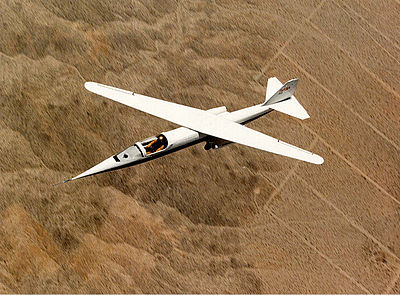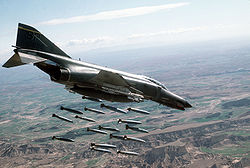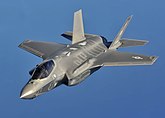Portal:Aviation
| Main page | Categories & Main topics |
|
Tasks and Projects |
The Aviation Portal

Aviation includes the activities surrounding mechanical flight and the aircraft industry. Aircraft includes fixed-wing and rotary-wing types, morphable wings, wing-less lifting bodies, as well as lighter-than-air craft such as hot air balloons and airships.
Aviation began in the 18th century with the development of the hot air balloon, an apparatus capable of atmospheric displacement through buoyancy. Some of the most significant advancements in aviation technology came with the controlled gliding flying of Otto Lilienthal in 1896; then a large step in significance came with the construction of the first powered airplane by the Wright brothers in the early 1900s. Since that time, aviation has been technologically revolutionized by the introduction of the jet which permitted a major form of transport throughout the world. (Full article...)
Selected article
Selected image

Did you know
...that the Heinkel He 46, designed for the Luftwaffe in 1931, was still being used to fight the Soviets in 1943? ...that Cornelius Vanderbilt Whitney was only twenty-eight years old when he helped found Pan American World Airways? .. that five UH-1 Iroquois helicopters of the Experimental Military Unit were shot down by a single Viet Cong soldier armed with an AK-47 rifle?
General images -
In the news
- May 29: Austrian Airlines cancels Moscow-bound flight after Russia refuses a reroute outside Belarusian airspace
- August 8: Passenger flight crashes upon landing at Calicut airport in India
- June 4: Power firm helicopter strikes cables, crashes near Fairfield, California
- January 29: Former basketball player Kobe Bryant dies in helicopter crash, aged 41
- January 13: Iran admits downing Ukrainian jet, cites 'human error'
- January 10: Fire erupts in parking structure at Sola Airport, Norway
- October 27: US announces restrictions on flying to Cuba
- October 3: World War II era plane crashes in Connecticut, US, killing at least seven
- September 10: Nevada prop plane crash near Las Vegas leaves two dead, three injured
- August 6: French inventor Franky Zapata successfully crosses English Channel on jet-powered hoverboard
Related portals
Associated Wikimedia
The following Wikimedia Foundation sister projects provide more on this subject:
-
Commons
Free media repository -
Wikibooks
Free textbooks and manuals -
Wikidata
Free knowledge base -
Wikinews
Free-content news -
Wikiquote
Collection of quotations -
Wikisource
Free-content library -
Wikiversity
Free learning tools -
Wikivoyage
Free travel guide -
Wiktionary
Dictionary and thesaurus
Selected biography
Assigned as a P-40 pilot with the 45th Fighter Squadron of the 15th Fighter Group at Wheeler Field, Hawaii, 2nd Lt. Gabreski witnessed the Japanese attack on Pearl Harbor, but did not become airborne in time to engage the attackers.
In March 1943 Gabreski became part of the 56th Fighter Group, flying the P-47 Thunderbolt, and in May was promoted to Major and named commander of the 61st Fighter Squadron, which included six Polish nationals as pilots in 1944. He made his 28th kill on July 5, 1944, passing Eddie Rickenbacker's record from World War I to become America's top ace (although several pilots passed him by the end of the war).
Col. Gabreski flew combat again during the Korean War, as commander of the 51st Fighter-Interceptor Wing, piloting an F-86 Sabre. He was credited with 6.5 MiG-15 kills, making him one of seven U.S. pilots to be aces in more than one war (the others are Col. Harrison Thyng, Col. James P. Hagerstrom, Major William T. Whisner, Col. Vermont Garrison, Major George A. Davis, Jr., and Lt.Col. John F. Bolt, USMC).
He ended his career as a commander of several tactical and air defense wings, his last assignment being commander of the 52d Fighter Wing at Suffolk County Air Force Base in Westhampton Beach, New York.
Selected Aircraft

The McDonnell Douglas F-4 Phantom II is a two-seat, twin-engined, all-weather, long-range supersonic fighter-bomber originally developed for the U.S. Navy by McDonnell Aircraft. Proving highly adaptable, it became a major part of the air wings of the U.S. Navy, U.S. Marine Corps, and U.S. Air Force. It was used extensively by all three of these services during the Vietnam War, serving as the principal air superiority fighter for both the Navy and Air Force, as well as being important in the ground-attack and reconnaissance roles by the close of U.S. involvement in the war.
First entering service in 1960, the Phantom continued to form a major part of U.S. military air power throughout the 1970s and 1980s, being gradually replaced by more modern aircraft such as the F-15 Eagle and F-16 Fighting Falcon in the U.S. Air Force; the F-14 Tomcat and F/A-18 Hornet in the U.S. Navy; and the F/A-18 in the U.S. Marine Corps. It remained in use by the U.S. in the reconnaissance and Wild Weasel roles in the 1991 Gulf War, finally leaving service in 1996. The Phantom was also operated by the armed forces of 11 other nations. Israeli Phantoms saw extensive combat in several Arab–Israeli conflicts, while Iran used its large fleet of Phantoms in the Iran–Iraq War. Phantoms remain in front line service with seven countries, and in use as an unmanned target in the U.S. Air Force.
Phantom production ran from 1958 to 1981, with a total of 5,195 built. This extensive run makes it the second most-produced Western jet fighter, behind the F-86 Sabre at just under 10,000 examples.
- Span: 38 ft 4.5 in (11.7 m)
- Length: 63 ft 0 in (19.2 m)
- Height: 16 ft 6 in (5.0 m)
- Engines: 2× General Electric J79-GE-17A axial compressor turbojets, 17,845 lbf (79.6 kN) each
- Cruising Speed: 506 kn (585 mph, 940 km/h)
- First Flight: 27 May 1958
- Number built: 5,195
Today in Aviation
- 2012 – The Free Syrian Army reports that Syrian government attack helicopters have helped drive its forces out of the government' air defense base at Al-Ghantu, which they had briefly captured.[1]
- 2012 – A Kenya Police Eurocopter AS350 crashes on a hill in the Kibiku area of the Ngong Forest just outside Nairobi, Kenya, killing all six people on board. Among the fatalities are Kenya's Minister of Interior Security and likely presidential candidate George Saitoti and Assistant Minister of Interior Security Joshua Orwa Ojode.
- 2011 – Syrian government attack helicopters go into action during Syrian Army military operations against the rebel stronghold of Jisr ash-Shugur. The operations will conclude successfully on 12 June.
- 2011 – The Government of Norway announces that it will begin a gradual withdrawal of the six Royal Norwegian Air Force F-16 Fighting Falcons it has committed to Operation Unified Protector, the NATO intervention in the Libyan Civil War.[2]
- 2008 – Sudan Airways Flight 109, an Airbus A310, crashes at Khartoum International Airport and breaks apart, catching fire. 30 deaths are confirmed, 6 passengers are listed as missing.
- 1999 – Canadian CF-188 Hornets began Operation Joint Guardian during the Kosovo Air War.
- 1990 – British Airways Flight 5390, a BAC One-Eleven, suffers explosive decompression over Didcot, Oxfordshire, England when one of the front windscreen panes blows out. The captain is partially sucked out of the cockpit, but a flight attendant manages to keep his unconscious body from falling from the aircraft. The first officer lands the aircraft safely at Southampton Airport. All on board survive.
- 1989 – First female USAF test pilot. Capt Jacquelyn S Parker graduated from the Air Force Test Pilot School at Edwards AFB CA.
- 1987 – The Boeing Model 360 makes its first flight. The tandem rotored helicopter served as an Advanced Technology Demonstrator of many new design concepts.
- 1967 – First flight of the Mikoyan-Gurevich MiG-23 prototype 23-11/1
- 1964 – First Lockheed XV-4A Hummingbird, 62-4503, (originally designated VZ-10) crashes, killing civilian Army test pilot. Aircraft had just transitioned from conventional to vertical flight at 3,000 feet (914 m) when control was lost. Airframe came down between Dobbins AFB and Woodstock, Georgia, injuring one civilian on ground.
- 1960 – Trans Australia Airlines Flight 538, a Fokker F-27, crashes into the ocean near Mackay, Queensland, Australia, killing all 29 on board in Australia's worst civilian air disaster. This crash was responsible for the mandatory installation of cockpit voice recorders in airliners in Australia, followed by the rest of the world.
- 1953 – The final experimental test flight for the turbojet powered #3 Douglas D-558-I Skystreak is flown by A. Scott Crossfield.
- 1944 – Flying from Italy carrying one 1,000-lb (454-kg) bomb each, 46 P-38 Lightning fighters of the U. S. Army Air Forces 82nd Fighter Group make a very-long-range fighter-bomber attack on the Romanian-American Oil Refinery at Ploesti, Romania. They destroy 23 German aircraft in exchange for the loss of 22 P-38 s.
- 1944 – RCAF fighter wings 144, 127 and 143 moved to France.
- 1943 – In one of the heaviest and most concentrated air attacks thus far in World War II, Allied aircraft drop 1,571 tons (1,425,202 kg) of bombs on Pantelleria.
- 1942 – An U. S. Army Air Forces LB-30 Liberator on a reconnaissance flight discovers that Japanese forces have occupied Kiska in the Aleutian Islands.
- 1936 – U.S. Navy Spartan NP-1, BuNo 3824, assigned at NAS Anacostia, Anacostia, D.C., ditches in the Back River, Virginia, after suffering engine failure following take-off from Langley Field, Virginia. Pilot J. Ware is KWF.
- 1919 – Ruth Law of the United States breaks the women’s altitude record, flying to 14,700 feet (4,481 m).
- 1913 – Marcel Brindejone des Moulinais wins the Pommeroy cup in Warsaw for the longest flight between sunrise and sunset, flying 900 miles from Paris.
- 1912 – The Austro-Hungarian submarine U-5 tows a kite balloon, apparently to determine the best coloration for submarines to avoid detection while underwater. Other than the experimental use of balloons from ships to bombard Venice in 1849 by its predecessor the Austrian Navy, it is the only operation of an observation balloon by the Austro-Hungarian Navy.
- 1908 – First flying club and civil airport established. Aeronautical Society chartered at New York City, and Morris Park air field established.
References
- ^ Solomon, Jay, and Nour Malad, "U.S. Bolsters Ties to Fighters in Syria," The Wall Street Journal, 13 June 2012 9:10 p.m. EDT.
- ^ "Libya Live Blog: Monday, August 1, 2011 – 16:56". Al Jazeera. 1 August 2011. Retrieved 2 September 2011.
- Shortcuts to this page: Portal:Airplanes • P:AVIA




















































